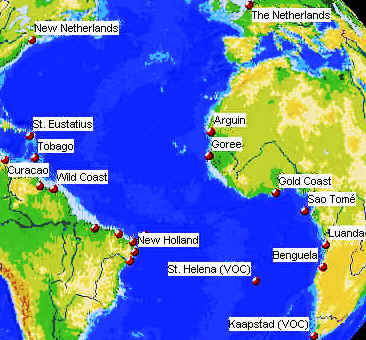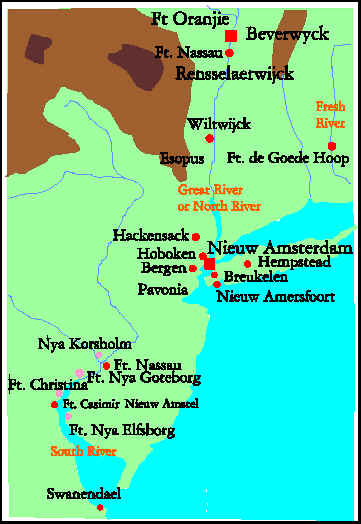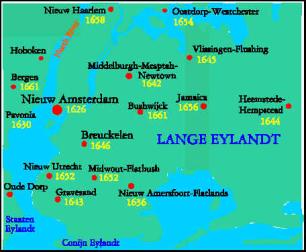Chapter 16 The World in the Age of European Expansion 1492-1763
|
Section
3 |
|
As Spain and Portugal consolidated their
empires in the Americas, the Dutch, English, and French established
competing empires of their own. The nature of their colonization
reflected their different goals and priorities. While the Dutch and
French were interested primarily in trade along mercantilist lines,
English colonization reflected a variety of different goals.
Although many Native American peoples tried to adapt to the changing
environment created by European colonization, disease and
competition over land drastically affected their traditional ways of
life. Northern Explorations Spain’s
and Portugal's profitable overseas colonies prompted other European
countries to send out explorers of their own. With royal support,
French and English expeditions sailed across the Atlantic in the
early 1500s. Like the Spanish and Portuguese, these countries were
primarily interested in finding a route to the treasures of Asia.
With Spain and Portugal in firm control of the southern routes,
however, they sought a Northwest
Passage—a waterway around or through North America.
In 1497 John Cabot, an Italian navigator in the pay of
England’s King Henry VII of England, sailed west to the coasts of
Newfoundland and Nova Scotia. When Cabot found no passage to China,
however, English seafarers spent the next half-century vainly
searching for a northeastern route through the Baltic Sea or around
Scandinavia. By the 1580s they had turned back to the west. In 1585
and 1587, Sir Walter Raleigh established short-lived colonies on
Roanoke Island, off the coast of what is now North Carolina.
Meanwhile, French explorers concentrated exclusively on the
northwestern route. In 1534 French explorer Jacques Cartier set sail
with a twofold mission: to search for the Northwest Passage, and to
discover new lands.[xlvi]
Although he never discovered a Northwest Passage, Cartier sailed up
the St. Lawrence River as far as present-day Montreal, and
established France's claims to eastern Canada, or New France, as he
called it.
As the Northwest Passage continued to elude them, France,
England, and the Netherlands eventually turned to colonization to
make a profit. During the 1600s all three countries took valuable
sugar-producing islands in the Caribbean from Spain and Portugal.
The major thrust of colonization, however, was aimed at North
America. Dutch and French Colonization The
French and the Dutch were primarily interested in trade along
mercantilist lines. The French also hoped to spread French Catholic
culture to the Native Americans. After initial unsuccessful attempts
under the patronage of the French clergy to establish colonization
for missionary purposes, eventually French colonization was
organized by the Crown, which preferred only loyal Catholics to
settle in New France. The French attempted to exclude potential
dissidents, such as the Huguenots, from the colony. The Dutch
preferred to encourage private companies like the Dutch West Indies
Company and the Dutch East Indies Company to establish colonies by
granting them a monopoly on any trade they might develop. Map of the main WIC (West Indies
Company) settlements in the Atlantic Ocean (1640s/1650s.). Taken
from http://www.colonialvoyage.com/wicmap.jpg
Critical to both French and Dutch colonization was the fur
trade. In 1603 Samuel de Champlain arrived in New France to trade
for furs, specifically beaver pelts. Champlain began exploring the
Great Lakes region and made agreements with local tribes to trade
their furs for European goods at a string of trading posts he
established. In 1608 he founded a permanent French settlement at
Quebec to act as a central collection point. French colonists also
settled at Montreal and in present-day Nova Scotia. From Canada, the
French gradually moved south. Between 1679 and 1683 René-Robert de
La Salle traveled down the Mississippi River to the Gulf of Mexico.
He claimed the entire inland region of North America for France,
calling it Louisiana after Louis XIV.
Meanwhile, sailing for a Dutch company in 1609, Henry Hudson
sighted present-day Manhattan Island and sailed up "as fine a
river as can be found, wide and deep, with good anchoring ground on
both sides."[xlvii]
In 1624 the newly chartered Dutch West India Company sent some 30
families to establish the colony of New Netherland in this Hudson
River Valley. [xlviii]
[xlix]
New
Netherland Colony, taken from http://www.colonialvoyage.com/newnetmap.jpg;
Nieuw Amsterdam,
Long
Island and environs 1664. Taken from http://www.colonialvoyage.com/longislmap.jpg In
1626 Peter Minuit, the first governor of the colony, bought
Manhattan Island from the local Canarsee tribes and founded New
Amsterdam, which later became New York City. By the early 1650s, New
Netherland contained some 2,000 settlers from all over Europe.
Clashes over land with local Native Americans, who were being
squeezed out of their own territory, convinced the company to
restrict further immigration and stick to fur trading.
French settlement was also relatively light. By 1750 only
about 70,000 French lived in all of North America. With trade as
their first priority,[l]
French officials encouraged traders to live among the Native
Americans, learning their ways and teaching them French ways. Many
traders married Native American women. French missionaries also did
their best to spread French Catholic culture. Both priests and nuns
learned Native American languages and customs. As Father Ragueneau,
a Jesuit priest, warned, "One must be very careful before
condemning a thousand things among their customs, which greatly
offend minds brought up and nourished in another world."[li]
English Colonialism English
colonization was more haphazard than that of the French and Dutch.
Like the Dutch government, the English Crown preferred not to risk
its own money on colonization ventures. Instead, it granted royal
charters to private English companies to establish the first
settlements. Also, unlike France, for many years the English
government was happy to see dissidents and troublemakers leave for
the colonies, often encouraging such migration to rid the country of
disruptive elements. With such loose royal control, private
companies soon established the first English colonies along the
North American coast. Settlement for profit.
The first permanent colony was established at Jamestown in Virginia
by the London Company in 1607, to find gold or other precious
metals. As John Smith, one of the leaders, put it, "There was
no talk, no hope, no work, but dig gold, wash gold, refine gold,
load gold." [lii]
When no gold was found, however, the company turned to tobacco to
recover its costs.[liii]
Tobacco had become popular in Europe. Although King James described
smoking as "a custom loathsome to the eye, hateful to the nose,
harmful to the brain, dangerous to the lungs,"[liv]
England imported 3 million pounds of the "noxious weed" in
1638 alone. With huge profits from tobacco, the Virginia colony
began to grow.
To attract new sources of labor, company officials offered
people free passage to the colony in exchange for a set number of
years of work, a system known as indentured servitude. The company also encouraged women to
immigrate, since "the plantation can never flourish till
families be planted, and the respect of their wives and children fix
[keep] the people on the soil."[lv]
Free Africans were among the early indentured servants, but as labor
demands rose the colonists resorted to importing African slaves.
Virginia's success encouraged others. By 1732 three
colonies—North Carolina, South Carolina, and Georgia—were
organized along similar economic lines. Some of the new settlers
came from the West Indies, bringing with them their knowledge of
plantation farming—and their African slaves. Along the coast and
in the interior, colonists established large plantations and small
farms. Besides tobacco, they grew export crops such as indigo, for
blue dye, and rice, which they learned to cultivate from West
African slaves. The forests provided wood and naval stores such as
tar and pitch.[lvi]
Religious colonization.
The search for wealth was not the sole motivation for European
colonization. As the Reformation and Counter Reformation continued
to disrupt people’s lives in Europe, many saw the Americas as a
haven where they could worship as they liked. The first such
religious colonists to arrive were the Pilgrims, who settled
Plymouth in 1620. A larger colony was established in 1630 around
present-day Boston by the Massachusetts Bay Company. The company had
been formed by English Puritans as part of the Great Migration, in which some 60,000 Puritans left England to
escape the "corrupt" English society of Charles I.
The Puritans of Massachusetts hoped one day to return to
England. In the meantime, as John Winthrop, first governor of the
colony, put it, they had come to the new world to establish a
“city on a hill” as an example for all. Only church members
could participate in the colony's government, and religious
conformity was strictly enforced.
As more and more people migrated to the colony, land
pressures and internal disagreements led some Puritans to establish
new settlements of their own. In 1636 Thomas Hooker and his
followers settled in what became Connecticut. Others left
Massachusetts because they could not bring themselves to conform to
the strict religious rule. For example, Roger Williams challenged
the religious government of the colony and was banished. He and a
few followers fled south, establishing the first settlement in Rhode
Island. Williams was outspoken in his support of religious
toleration for all. His colony soon became a haven for another
dissenter, Anne Hutchinson. [BIOGRAPHY] Born in
Alford, England in 1591, Hutchinson was raised in a strict Puritan
family. Like many Puritan families, in 1634 the Hutchinsons migrated
to the Massachusetts Bay Colony. Inspired by the teachings of the
Puritan minister John Cotton, Hutchinson held weekly meetings in her
home to discuss his sermons and to present her own interpretations
of the Bible. Rejecting the concept of original sin, she insisted
that people could communicate directly with God. [lvii]
Hutchinson soon began to speak out against ministers in the
colony who interpreted the Bible literally.[lviii]
By suggesting that people should follow their own consciences in
matters of faith, however, many thought Hutchinson was undermining
the authority of the community’s religious government. Her attacks
quickly brought the combined force of church and state against her.
Eventually, Governor Winthrop ordered her to stop preaching or
suffer banishment.[lix]
Hutchinson replied:
“You have no power over my body, neither can you do me any
harm. . . . No further do I esteem of any mortal man. . . . I fear
none but the great Jehovah [God], . . . and I do verily believe that
he will deliver me out of your hands. . . . Therefore, take heed how
you proceed against me.”[lx] When
Hutchinson claimed to have heard God’s voice directly, however,
the shocked colonists denounced her for heresy. In 1638 she moved
with her family to Rhode Island. After her husband died, she moved
to New Netherland, where Native Americans killed her in 1643.
The same search for religious tolerance that had motivated
Williams and Hutchinson also inspired the founding of several other
colonies. In the 1630s Cecilius Calvert, second Lord Baltimore,
established a haven for English Catholics in his colony of Maryland.
Accepting the principle of religious tolerance, Lord Baltimore
eventually opened the colony to anyone. Farther north the Quaker
leader William Penn established Pennsylvania on a similar basis of
tolerance in the 1680s. A Clash of Cultures Although
neither the French nor the Dutch were particularly interested in
conquering the Native Americans, the foreign presence nevertheless
brought enormous changes to the Native Americans’ way of life.
Some Native American leaders understood the implications of cultural
interaction, and worried about its effects. As one Native American
leader told Champlain in 1633:
“You will build a house that is a fortress, then you will
build another house . . . and then we will be nothing but dogs that
sleep outdoors. . . . You will grow wheat, and we will no longer
look for our sustenance in the woods; we will be no better than
vagabonds. . . . You pinch our arms, and we will tremble.”[lxi] Changes
did occur, particularly as the Native Americans adapted to the fur
trade.
Most of the tribes between the Hudson Bay in the north and
the Great Lakes and the St. Lawrence in the south became involved in
the French fur trade. In the early 1600s the Huron tribe north of
Lake Ontario organized a trading empire with the Ottawa and
Nipissing tribes of Lake Huron. The Huron traded agricultural
products of their own for furs gathered by tribes farther north and
west. Carrying the furs to Montreal or Quebec, the Huron traded them
for European-made knives, axes, cloth, and other merchandise.
Returning west, they used some of the European goods to get more
furs from their Native American suppliers. Farther south, the
Iroquois League became similarly involved with Dutch fur traders.[lxii]
As the European demand for furs continued to increase, some
tribes over hunted the beaver in their own territories. Such
ecological catastrophes could upset local balances of power. The
Iroquois League, for example, having trapped out their own territory
in the 1640s, decided to capture the trade of the Huron. The
subsequent vicious conflict nearly destroyed many tribes around Lake
Erie. Such wars became even more common as the Native Americans’
various European allies also fought each other over trade and land,
drawing their tribal allies into the fighting.
The worst conflicts, however, developed between Native
Americans and Europeans over land. Violent land disputes underlay
the Dutch decision to restrict immigration and stick to fur trading
as the basis for the New Netherland colony. Such disputes were even
more common between local Native Americans and English colonists in
search of free land.
As more and more European settlers arrived in North America,
they soon outnumbered the Native Americans, whose population had
been severely reduced by disease brought by settlers. English
settlers often interpreted the great epidemics as signs of God's
blessing on their own settlement. Edward Johnson, an early settler
in Puritan New England, expressed this view when he described the
catastrophic death rate of the Indians just before the Puritans
arrived: "There
befell a great mortality among them; the greatest that ever the
memory of father or son took notice of, desolating chiefly those
places where the English afterward planted; sweeping away whole
families, but chiefly young men and children, the very seeds of
increase. . . . Their wigwams lie full of dead corpses. . . . By
this means, Christ, whose great and glorious works throughout the
earth are all for the benefit of his churches and chosen, not only
made room for his people to plant, but also tamed the hearts of
these barbarous Indians."[lxiii]
With conflicting ideas about how to use the land, English
settlers and Native Americans pursued ways of living that were often
at odds. Eventually, the technology and greater numbers of the
colonists prevailed. Despite considerable resistance, Native
American peoples were driven off their lands, and often destroyed
altogether. European settlers eventually drove out even the farming
tribes of the Southeast, who tried to adapt to European methods.
With more land coming under cultivation, European settlers,
especially in southern colonies, soon found themselves in need of
workers. As the Spanish and Portuguese had done under similar
circumstances in Central and South America, now the North American
colonists turned to Africa to provide slave laborers. It was a
fateful development that would affect three continents and the fate
of millions of people.
Section 3 Review IDENTIFY and
explain the significance of the following: Northwest
Passage John
Cabot Jacques
Cartier Samuel
de Champlain René-Robert
de La Salle Henry
Hudson Dutch
West India Company Peter
Minuit indentured
servitude Great
Migration Anne
Hutchinson John
Winthrop LOCATE and explain the importance of the following: St.
Lawrence River Quebec Louisiana Manhattan
Island New
Netherland Jamestown
Plymouth 1.
Main Idea What was France's motive
in establishing overseas colonies? 2.
Main Idea How did the Dutch
establish their American colony? 3.
Geography: Movement
What geographic features determined the exploration and
settlement of New France and Louisiana? 4.
Synthesizing
How did the settlement of Europeans in North America affect
Native American populations In your answer, consider the situation
in New France, New Netherland, and English America. |


